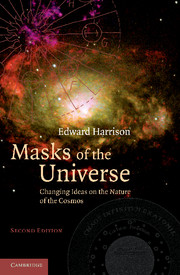Book contents
- Frontmatter
- Contents
- Prefece
- 1 Introducing the Masks
- Part I Worlds in the Making
- Part II The Heart Divine
- 8 Dance of the Atoms and Waves
- 9 Fabric of Space and Time
- 10 What Then is Time?
- 11 Nearer to the Heart's Desire
- 12 The Cosmic Tide
- 13 Do Dreams Come True?
- Part III The Cloud of Unknowing
- Bibliography
- Index
9 - Fabric of Space and Time
Published online by Cambridge University Press: 27 October 2009
- Frontmatter
- Contents
- Prefece
- 1 Introducing the Masks
- Part I Worlds in the Making
- Part II The Heart Divine
- 8 Dance of the Atoms and Waves
- 9 Fabric of Space and Time
- 10 What Then is Time?
- 11 Nearer to the Heart's Desire
- 12 The Cosmic Tide
- 13 Do Dreams Come True?
- Part III The Cloud of Unknowing
- Bibliography
- Index
Summary
We take space and time for granted. Normally they do not trouble us, yet whenever we think about them we become puzzled.
Space seems simple enough. Here it is, all around us, stretching away and spanning everything in the external world. We are surprised when told that people in other cultures have different ways of regarding space. What is there about it that can possibly be different? Edward Hall in The Hidden Dimension says, “there is no alternative to accepting the fact that people reared in different cultures live in different sensory worlds” – in other worlds of space. It seems that the Arabs, Japanese, Hopi, and the people of many other cultures have different modes of expression concerning arrangements and relations in space; they live in different mental worlds – in other worlds of space.
Time is much more puzzling. Here it is in our imagination, stretching away, spanning everything in the past, present, and future. But unlike space it is not all around us and directly accessible. We experience time within ourselves, it seems, and cannot perceive it directly in the external world. Those intervals of minutes and hours on the face of a clock are actually intervals of space. A second cannot be displayed directly in pure form in the external world in the same way as a centimeter.
- Type
- Chapter
- Information
- Masks of the UniverseChanging Ideas on the Nature of the Cosmos, pp. 141 - 162Publisher: Cambridge University PressPrint publication year: 2003



